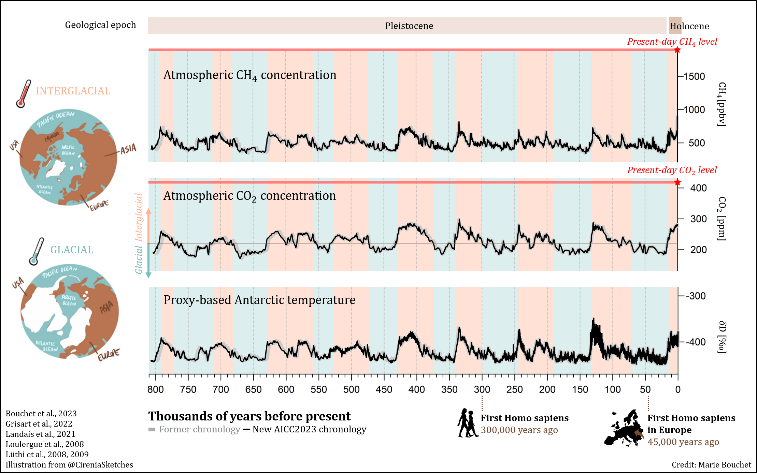
Figure: EPICA Dome C records of CH4, CO2 and (δD reflecting local surface temperature on the old AICC2012 and the new AICC2023 age models. Red stars indicate the present-day levels for greenhouse gases concentration.
To understand the phasing of external forcing (amount of solar energy received at the Earth’s surface), climate response and internal feedbacks (greenhouse gases concentration, ice sheet dynamics, oceanic and atmospheric circulations, …) dating climate archives is crucial. Ice cores are unique archives because they provide a direct record of greenhouse gas concentration. However, dating ice cores is particular since they require two chronologies: one for the ice and one for the younger air trapped in bubbles. The EPICA (European Project for Ice Coring in Antarctica) Dome C drilling in East Antarctica reaches a depth of 3260 m. Its age scale covers the last 800,000 years and was obtained in the framework of AICC2012 (Antarctic Ice Core Chronology 2012), established for five ice cores in Antarctica and Greenland using the following method. A sedimentation model is used to calculate prior ice and gas age scales from a background scenario of three variables: accumulation of snow at the surface, ice thinning and lock-in-depth, the lowest depth where air is enclosed in bubbles and no longer diffuses. A Bayesian model then statistically adjusts the age scales, and the three above-mentioned variables, so that they respect chronological observations (dating constraints, stratigraphic links between cores, tephra layers…). The AICC2012 chronology is associated with an uncertainty reaching 8,000 years at the bottom of the core mainly due to the low resolution of the data and to the uncertainties related to the dating strategy. Here, we present new data on EDC ice core and we improve the dating precision.
New data consist in additional absolute age constraints derived from the 81Kr radioisotope measured in air trapped in EDC ice core and new orbital age constraints obtained by synchronizing EDC ice core records with curves of reference. Among these records, we have the air isotopic composition (δ18O, δO2/N2), recently measured at high-resolution over the last 800,000 years, and the total air content signal now spanning the entire core. Volcanic bipolar synchronization provides additional stratigraphic links, relating EDC to other cores and reducing the uncertainty on recent periods. Finally, we use new constraints on the lock-in-depth to connect ice and gas timescales. They include high resolution measurements of air isotopic composition (δ15N) and snowpack modeling estimates when data is missing. Then, the Bayesian dating tool Paleochrono is used to construct new gas and ice chronologies associated with a reduced uncertainty of 900 years on average. The new timescale diverges from AICC2012 and suggests age shifts reaching 3,800 years towards older ages over interglacial periods of Marine Isotope Stages 5, 11 and 19. The agreement with precise Argon-dated Mediterranean tephrochronology and Uranium-Thorium dated speleothems from Northern Alps is improved by 1,000 to 2,000 years over these time intervals.
Auteurs: Marie Bouchet, Amaëlle Landais, Antoine Grisart, Frédéric Parrenin, Frédéric Prié, Roxanne Jacob, Elise Fourré, Emilie Capron, Dominique Raynaud, Vladimir Ya Lipenkov, Marie-France Loutre, Thomas Extier, Anders Svensson, Etienne Legrain, Patricia Martinerie, Markus Leuenberger, Wei Jiang, Florian Ritterbusch, Zheng-Tian Lu, Guo-Min Yang.






